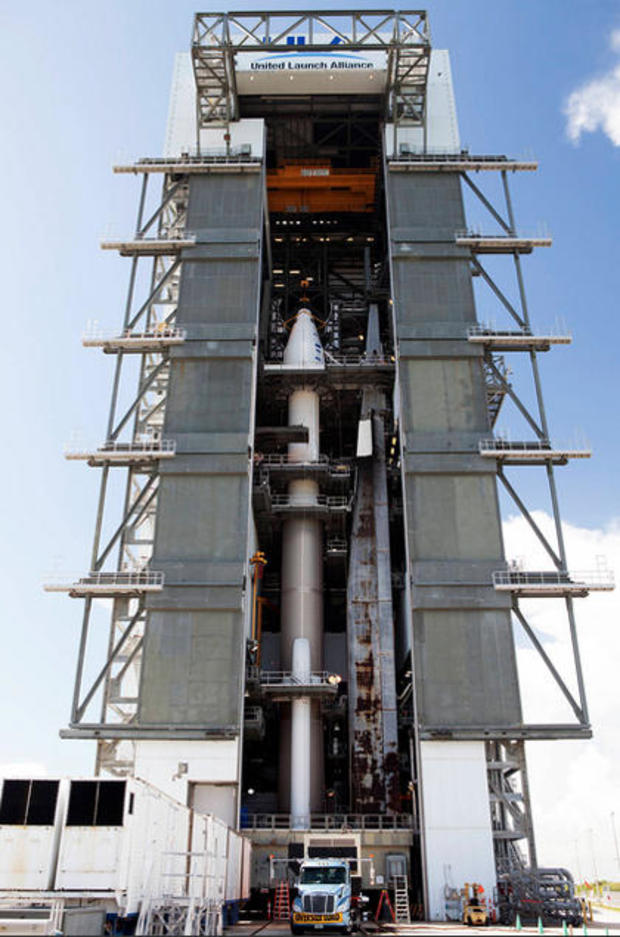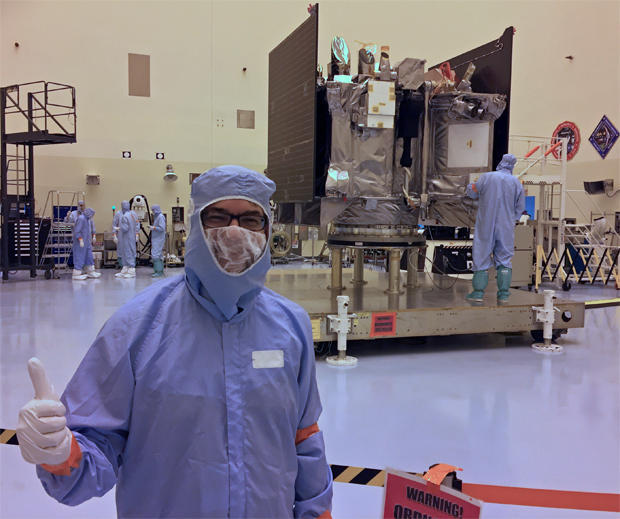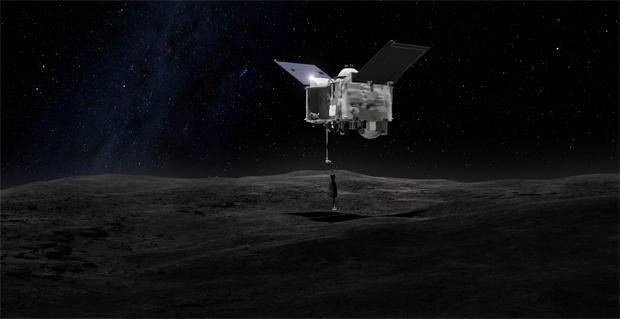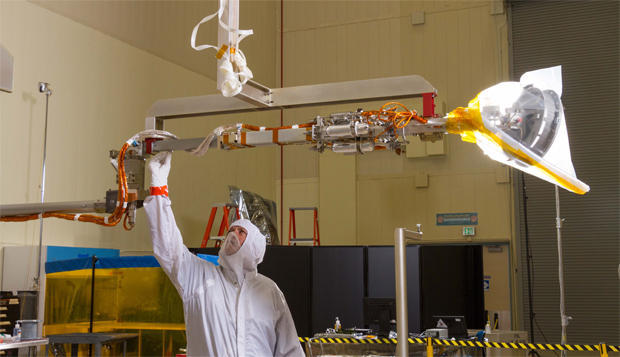Asteroid sample mission readied for launch
NASA is launching an ambitious billion-dollar science mission Thursday, sending an SUV-size, robot arm-equipped spacecraft on a two-year voyage to a nearby asteroid to map its surface, search for organic compounds, collect a precious soil sample and return it to Earth for detailed laboratory analysis.
The OSIRIS-REx spacecraft -- the convoluted acronym stands for Origins, Spectral Interpretation, Resource Identification, and Security-Regolith Explorer -- is scheduled for liftoff atop a United Launch Alliance Atlas 5 rocket at 7:05 p.m. EDT (GMT-4) Thursday. Forecasters are predicting an 80 percent chance of good weather.
Launch from complex 41 at the Cape Canaveral Air Force Station will come just one week after a fully fueled Falcon 9 rocket built by arch-rival SpaceX exploded during a pre-flight test just 1.5 miles away, at launch complex 40, rocking the area with a ground-shaking blast.
While the explosion destroyed the $62 million Falcon 9 rocket and its $195 million satellite payload, ULA engineers said the Atlas 5 and OSIRIS-REx, housed at the time inside a protective vertical processing building, were not affected and launch preparations were not interrupted.
And so, the stage is set for launch on a two-year voyage to a small near-Earth asteroid known as Bennu, believed to be a carbon rich remnant of the original cloud of gas and dust that coalesced to form the solar system 4.6 billion years ago.
Using a sophisticating mapping camera, two mineral sniffing spectrometers, a laser altimeter and a student-managed X-ray imaging system, OSIRIS-REx will study Bennu in extraordinary detail before unlimbering a robot arm in July 2020, two years after arrival in August 2018, to collect a surface sample.
Flying in precise formation with the slowly rotating asteroid, OSIRIS-REx will extend its arm to push a clever 12-inch-wide sample collector onto the surface in a robotic high five of sorts. During the five seconds or so the collector is in contact, nitrogen gas will shoot out, stirring soil and small particles away from the surface so they can be captured.
Enough nitrogen is available for up to three sample collection attempts, but engineers are hopeful only one will be necessary. The goal is to capture at least 2.1 ounces of material and, depending on the nature of the surface and the duration of the sampling attempt, up to 4.4 pounds.
With the collected material safely stowed in a re-entry capsule, OSIRIS-REx will bid Bennu farewell in March 2021, setting off on a two-year voyage back to Earth. The 100-pound sample capsule will be released on Sept. 24, 2023, hitting Earth’s atmosphere at a blistering 27,000 mph before a gentle parachute-assisted touchdown in Utah.
From there, the samples will be flown to Astromaterials Acquisition and Curation Office at the Johnson Space Center in Houston, where Apollo moon rocks are stored, and subjected to two years of detailed analysis.
Three quarters of the material will be stored for future study and some will be distributed to Canadian and Japanese collaborators. And then, at the end of September 2025, the OSIRIS-REx mission finally will come to an end.
Standing in a clean room at the Kennedy Space Center on Aug. 20, wearing protective coveralls, gloves, a face mask and hood to minimize any chance of contamination, University of Arizona principal investigator Dante Lauretta discussed the mission with two similarly-garbed reporters as engineers readied the spacecraft for the short trip to the launch pad.
The mission began, he recalled, with scribbles on a cocktail napkin in a Tucson bar.
“2004 was the concept, literally three guys in a bar sitting around saying hey, we should gin up an asteroid mission and bid this to NASA,” Lauretta said. “2025, in September, it’ll be lights out, we’re done with the program, the science papers have been published. That’s 21 years of my career. I was 33 years old when I got involved in the program and I’ll be 54 when it’s over. So it’s pretty much my professional life.”
Admiring his spacecraft, its solar arrays and robot arm folded away and its sample return capsule safely stowed, Lauretta marveled, “it’s a beautiful spacecraft; it really has behaved very well for us. So I’m happy to send it on the journey to Bennu and back. But I’m also going to miss just the awesome engineering that is the privilege of this position.”
But the scientific payoff will be worth it when the largest sample of pristine extraterrestrial material brought back to Earth since the Apollo moon program is finally under the microscopes in Houston.
“OSIRIS-REx is going to help us understand how the solar system works and the nature of the bodies in the solar system,” said Jeff Grossman, OSIRIS-REx program scientist at NASA headquarters.
“It’s going to help us understand how the solar system formed. It’s going to inform our understanding for the potential for life in the solar system, on Earth and elsewhere. But it also advances our more practical goals of understanding the resources of the near-Earth solar system as well as the hazards.”
Said Jim Green, NASA’s director of planetary science: “This is a dark asteroid that we have found. We’re going to hunt it down, we’re going to orbit, we’re going to take a good look at it, and we’re going to bring back a sample.”
“This is a fantastic mission,” he said.
The Atlas 5’s Russian RD-180 first-stage engine, a single strap-on solid fuel booster and a powerful hydrogen-fueled Centaur second stage will accelerate the 4,650-pound OSIRIS-REx to an Earth-departure velocity of more than 14 miles per second before releasing it to fly on its own 55 minutes after launch.
To change the tilt of its trajectory, OSIRIS-REx will loop around the sun once and make a close flyby of Earth on Sept. 22, 2017, using the planet’s gravity for a velocity-boosting assist. If all goes well, the spacecraft will catch up with its quarry in August 2018, precisely matching Bennu’s 63,000 mph pace around the sun.
Originally catalogued as 1999 RQ36, Bennu was discovered Sept. 11, 1999, and later renamed after an international contest won by then third-grader Michael Puzio. He suggested Bennu, an Egyptian mythological deity associated with creation and rebirth.
Bennu is roughly spherical with a diameter of about 1,614 feet and an estimated mass of about 85.5 million tons. The asteroid rotates once ever 4.3 hours and takes 1.2 years to complete one trip around the sun at distances ranging from 126 million miles to 83 million miles. It is an almost black, B-type asteroid with a density similar to coal.
It is classified as a potentially hazardous asteroid, or PHA, because its orbit carries it within five million miles of Earth’s orbit and it is large enough to survive atmospheric entry in a collision.
Bennu poses no threat to Earth for more than a century, tracking shows, but based on more than two dozen radar observations and nearly 500 telescopic studies, experts predict a 1-in-2,700 chance of impact between 2175 and 2199. Lest anyone get unduly alarmed, that means the probability of a miss is better than 99.9 percent.
Bennu was selected as the target for OSIRIS-REx because it is close enough to reach in a reasonable amount of time, it is rotating slowly enough for the spacecraft to “match rates” for sample collection, it is rich in carbon compounds and, possibly, organic precursors to life, and it is representative of bodies that pose a potential threat to Earth.
But the “O” in OSIRIS-REx stands for “origins,” and Bennu fits the bill as an untouched relic of the solar system’s formation, composed of the same raw materials that went into building the sun and planets.
“We’re going to an asteroid that represents the first building blocks of the planets in our solar system,” Lauretta said. “Four-and-a-half billion years ago, the solar system was a giant cloud of rotating gas and dust and the particles were millimeter size or smaller.
“These objects slowly accreted and accumulated into larger and larger objects. In many cases, they got completely collected into large bodies like the Earth or even larger bodies like the core of Jupiter. However, because Jupiter was such a massive planet, its gravitational field perturbed the belt of material right in front of it, preserving those geologic remnants from the earliest days of solar system formation.”
Carbon-rich asteroids like Bennu are believed to “hold precious organic molecules that were the precursors of life on our planet,” he said.
“We’re talking about things that are present at part-per-billion levels in the material, something you could never analyze at the asteroid with an instrument on the spacecraft,” he continued. “So we need to get these into our laboratories to address the fundamental science origins objective that is OSIRIS-REx.”
But it won’t be easy. And it won’t be quick.
Approaching Bennu in 2018, OSIRIS-REx’s cameras will search for any plumes or small satellites that might pose a threat to the spacecraft before matching orbits with the asteroid and building up an initial global map of its surface.
The spacecraft then will begin the “detailed survey” phase, using its instruments to characterize the asteroid’s geologic structure and its spectral and thermal properties, the first step in finding an appropriate sample collection site.
Scientists also will study a phenomenon known as the Yarkovsky Effect to learn how solar heating and cooling can cause subtle changes in a body’s trajectory. The observations could lead to improved tracking of potential threats.
The next phase of the mission calls for studying Bennu at even higher resolution, using the laser altimeter to build up a detailed topographic map and focusing on a dozen possible landing sites selected during the detailed survey phase.
In the reconnaissance phase, OSIRIS-REx will make low-altitude passes over the potential sample sites to help scientists make a final selection.
“We have phenomenal capabilities when we’re in orbit around the asteroid to be able to target potential sample sites, or regions of interest, and do very high resolution characterization of that material to really make sure we get the most scientifically valuable sample,” Lauretta said. “But we’re also going to understand the global properties of the asteroid so we can put the sample site into the proper context.”
Finally, two years after arrival, the stage will be set for sample collection.
The “Touch-and-Go Sample Acquisition Mechanism,” or TAGSAM, features a folding 10-foot-long arm and a cake pan-like head that will be extended until it contacts Bennu’s surface at a relative velocity of about .22 mph. A dedicated camera will document the entire process.
The TAGSAM system is designed to keep the sampler head in contact with the surface for about five seconds while a jet of nitrogen gas stirs up the surface material just under the collector. Some of that kicked-up material will be captured in a filter. Adding to the haul, dust-size particles on the surface will stick to pads on the bottom of the collector.
But all of that depends on exactly what the TAGSAM encounters when it touches Bennu’s surface.
“It’ll be a first-time event, never been done in spaceflight history,” Lauretta said. “So there’s inherent risk anytime you’re trying to plan a maneuver like that. However ... we have this go-slow approach, and we’re not going to get the sample until absolutely we feel like the spacecraft is ready and the team is ready on the ground.”
Even so, Lauretta said, “the nature of an asteroid’s surface, a rubble-pile asteroid in microgravity, is a new realm of physics, and we’re not exactly sure what the surface is going to be like. ... Is it going to be fluid, is it going to be quicksand, is it going to be cement? What are we expecting when we get out there?”
No one yet knows. But the sample collection attempt will be “a great science experiment, and we’re going to learn an enormous about about asteroid surface properties,” Lauretta said. “We feel like we’ve bounded the stressing cases, but we are explorers, and this is the unknown, and we’re doing something for the first time. We’ve done everything we can to minimize the risk.”
Success will be measured by withdrawing from the asteroid, keeping the arm extended and spinning the spacecraft. Careful measurements of that spin will tell scientists exactly how much material might have been captured.
Once collection is deemed complete, the arm then will move the collector head to OSIRIS-REx’s open sample return container and place it inside for the two-and-a-half-year trip back to Earth. Another camera will document the storage procedure.
Approaching Earth in September 2023, OSIRIS-REx will be on a trajectory that lines up with the Utah Test and Training Range about 80 miles west of Salt Lake City. Two hours before atmospheric entry, the sample container will be released and OSIRIS-REx will change course, putting itself into a long orbit around the sun.
The aerodynamic, heat-shield-equipped sample container, identical to one successfully used during an earlier comet sample return mission, will hit the atmosphere at about 27,000 miles per hour, rapidly slowing and then free-falling toward the surface. At an altitude of about two miles, a parachute will deploy, slowing the container for touchdown.
“It really is a great adventure. We’re going out into the unknown, we’re bringing back scientific treasure,” Lauretta said. “For me, looking forward to the day in 2023 when we open up that sample return capsule is what’s driven me for the past 12 years and what’s going to keep this going for the next seven.”




